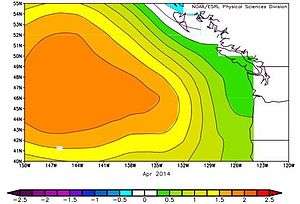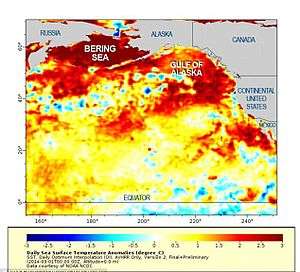The Blob (Pacific Ocean)
The Blob was a large mass of relatively warm water in the Pacific Ocean off the coast of North America. It was first detected in late 2013 and continued to spread throughout 2014 and 2015.[1][2] It is also known as a marine heatwave. Sea surface temperature indicated that The Blob persisted into 2016,[3] but was thought to have dissipated later that year.

This warm water mass was unusual in ocean conditions and was considered to have a role in the formation of the unusual weather conditions felt in the Pacific Coast of North America.[1] The warm waters of the Blob were nutrient poor and adversely affected marine life.[4] By September 2016, "The Blob" resurfaced and made itself known to meteorologists.[5]
Origin
The Blob was first detected in the autumn of 2013 and the early months of 2014 by Nicholas Bond of the Joint Institute for the Study of the Atmosphere and Ocean of the University of Washington, and his colleagues, when a large circular body of sea-water did not cool as expected and remained much warmer than the average normal temperatures for that location and season.[6]
Bond, then the State Climatologist for Washington, coined the term "The Blob", with the term first appearing in an article in the monthly newsletter of the Office of the Washington State Climatologist for June 2014.[7]
Description

Initially the Blob was reported as being 500 miles (800 km) wide and 300 feet (91 m) deep.[1] It expanded and reached the size 1,000 miles (1,600 km) long, 1,000 miles (1,600 km) wide and 300 feet (91 m) deep, in the month of June 2014 when the term "The Blob" was coined.[7][8][9] The Blob now hugs the coast of North America from Mexico to Alaska and beyond, over a stretch of 2,000 miles (3,200 km) and more, and has formed three distinct patches, the first, off the coast of Canada, Washington, Oregon, and California, a region known to oceanographers as the Coastal Upwelling Domain; the second off Alaska and in the Bering Sea; and the third and smallest, off Southern California and Mexico.[6][10]
In February 2014, the temperature of the Blob was around 2.5 °C (4.5 °F) warmer than what was usual for the time of year.[8][11]
A NOAA scientist noted in September 2014, based on ocean temperature records, that the North Pacific Ocean had not previously experienced temperatures so warm since climatologists began taking recordings.[9]
Cause
The immediate cause of the phenomenon was the lower than normal rates of heat loss from the sea to the atmosphere, compounded with lower than usual water circulation resulting in a static upper layer of water. Both of these are attributed to a static high pressure region in the atmosphere, termed the Ridiculously Resilient Ridge, which has existed since spring 2014.[12] The lack of air movement impacts the wind-forced currents and the wind-generated stirring of surface waters. These in turn have influenced the weather in the Pacific Northwest from the winter of 2013–2014 onwards and may have been associated with the unusually hot summer experienced in the continental Pacific Northwest in 2014.[11]
The reason for the phenomenon remains unclear. Some experts consider that the wedge of warm water portends a cyclical change with the surface waters of the mid-latitude Pacific Ocean flipping from a cold phase to a warm phase in a cycle known as the Pacific decadal oscillation (PDO).[1] This poorly-understood change happens at irregular intervals of years or decades. During a warm phase, the west Pacific becomes cooler and part of the eastern ocean warms; during the cool phase, these changes reverse.[13] Scientists believe a cold phase started in the late 1990s and the arrival of the Blob may be the start of the next warm phase. The PDO phases may also be related to the likelihood of El Nino events.[1]
NASA climatologist William Patzert predicts that if the PDO is at work here, there will be widespread climatological consequences and southern California and the American South may be in for a period of high precipitation, with an increase in the rate of global warming. Another climatologist, Matt Newman of the University of Colorado, does not think the Blob fits the pattern of a shift in the PDO. He believes the unusually warm water is due to the persistent area of high pressure stationary over the northeastern Pacific Ocean. Dan Cayan of the Scripps Institution of Oceanography is unsure about the ultimate cause of the phenomenon, but states "there's no doubt that this anomaly in sea surface temperature is very meaningful".[1]
Effects
Ecosystem disruption
Sea surface temperature anomalies are a physical indicator which adversely affect the zooplankton (mainly copepods) in the Northeast Pacific and specifically in the Coastal Upwelling Domain. Warm waters are much less nutrient-rich than the cold upwelling waters which were the norm till recently off the Pacific Coast.[14] This results in reduced phytoplankton productivity with knock on effects on the zooplankton which feed on it and the higher levels of the food chain.[11] Species lower in the food web that prefer colder waters, which tend to be fattier were replaced by warmer water species of lower nutritional value.[15]
The Northwest Fisheries Science Center, Seattle predicted reduced catches of coho and Chinook salmon, a major contributing factor being the raised temperatures of seawater in the Blob.[14] Salmon catches dropped as the fish migrated away having found low levels of zooplankton.[6]
Thousands of sea lion pups are starving in California leading to forced beachings.[16] Thousands of Cassin's auklets in Oregon have starved due to lack of food.[16]
Animals which favour warm waters and which have never been seen as far north as Alaska, have been spotted, examples being the warm water thresher sharks (Alopias spp) and ocean sunfish (Mola mola).[9][16] In the spring of 2016, acres of Velella velella were reported in the waters south of the Copper River Delta.[17]
The discovery of a skipjack tuna (Katsuwonus pelamis), primarily a fish of warm tropical waters, off Copper River, in Alaska, 200 miles (320 km) north of the previous geographic limit, and a dead sooty storm-petrel (Oceanodroma tristrami), a species native to Northern Asia and Hawaii, along with a few brown boobies (Sula leucogaster) in the Farallon Islands of California, besides other such records, has led to worries amongst marine biologists that the food web across the Pacific is in danger of disruption.[16]
Biologists from The University of Queensland observed the first ever mass bleaching event for Hawaiian coral reefs in 2014, and attributed it to the blob.[18]
Weather and seasons
Research from the University of Washington found positive temperature anomalies in the NE Pacific Ocean (upper ~100 m, greater than 2.5 °C, with temperatures at the coast below normal) for the winter period of 2013–2014. Heat loss from the ocean during the winter time was suppressed. During spring and summer 2014 the warmer sea surface temperature anomalies reached coastal waters. The anomaly may have had a significant effect on the unusually warm summer of 2014, with record high temperatures over parts of land in the Pacific Northwest. Offshore sea surface temperatures (SSTs) in the NE Pacific for the month of February were the greatest at least since the 1980s, possibly as early as 1900. Additionally they found anomalous sea surface pressure SSP, with a peak magnitude approaching 10 hPa, a record high value for the years of 1949–2014.[11]
Canadian senior climatologist David Phillips noted in May 2015 about the coming winter season, "If that blob continues, if it stays warm ... and then you add to that El Nino, it may complement each other and then it may be the year winter is cancelled."[19]
See also
References
- Monte Morin (24 April 2015). "Wedge of warm seawater known as 'the blob' blamed for marine havoc". phys.org. Retrieved 27 April 2015.
- NASA Earth Observatory (16 February 2016). "The Demise of the Warm Blob". Retrieved 29 June 2016.
- Thoman, Rick (19 May 2016). "The Blob Lives: Update from Rick Thoman". Alaska Ocean Observing System. Retrieved 21 May 2016.
- Innis, Michelle (9 April 2016). "Climate-Related Death of Coral Around World Alarms Scientists". The New York Times. Retrieved 15 April 2016.
- Belles, Johnathan (21 September 2016). "The Blob is Back: Anomalous Warmth Returns to the North Pacific Ocean". The Weather Channel. Retrieved 30 April 2017.
- Almasy, Steve; Hennen, Dave & Gray, Jennifer (22 April 2015). "Blob of warm Pacific water threatens ecosystem, may intensify drought". CNN.com. Retrieved 28 April 2015.
- Bond, Nicholas (3 June 2014). "The Blob: Warm Water off the Coast of the PNW and What it May Mean for Our Summer Weather – A message from the State Climatologist" (PDF). Monthly Newsletter. Office of the Washington State Climatologist: 2–4. Retrieved 28 April 2015.
- Hickey, Hannah (9 April 2015). "'Warm blob' in Pacific Ocean linked to weird weather across the US". Science Daily. Retrieved 30 April 2015.
- Milstein, Michael (September 2014). "Unusual North Pacific warmth jostles marine food chain". Northwest Fisheries Science Center. Retrieved 30 April 2015.
- Peterson, William T.; Morgan, Cheryl A.; Peterson, Jay O.; Fisher, Jennifer L.; Burke, Brian J. & Fresh, Kurt (December 2014). Ocean Ecosystem Indicators of Salmon Marine Survival in the Northern California Current (PDF). Newport, Oregon: National Marine Fisheries Service (Fish Ecology Division, Northwest Fisheries Science Center) & Cooperative Institute for Marine Resource Studies, Hatfield Marine Science Center. Retrieved 28 April 2015.
- Bond, Nicholas A.; Cronin, Meghan F.; Freeland, Howard; Mantua, Nathan (2015). "Causes and Impacts of the 2014 Warm Anomaly in the NE Pacific". Geophysical Research Letters. 42 (9): 3414–3420. Bibcode:2015GeoRL..42.3414B. doi:10.1002/2015GL063306.
- Morin, Monte (19 April 2015). "Wedge of warm seawater known as 'the blob' blamed for marine havoc". Los Angeles Times. Retrieved 17 October 2015.
- Mantua, Nathan J.; Hare, Steven R.; Zhang, Yuan; Wallace, John M.; Francis, Robert C. (1997). "A Pacific interdecadal climate oscillation with impacts on salmon production". Bulletin of the American Meteorological Society. 78 (6): 1069–1079. Bibcode:1997BAMS...78.1069M. doi:10.1175/1520-0477(1997)078<1069:APICOW>2.0.CO;2.
- "Forecast of Adult Returns for Coho salmon and Chinook Salmon (2014–2016)". Northwest Fisheries Science Center. Retrieved 28 April 2015.
- Lu, Jennifer (15 January 2020). "Scientists were stumped when seabirds started dying. Now they have answers". Los Angeles Times. Retrieved 16 January 2020.
- Welch, Craig (11 April 2015). "Warming Pacific Makes for Increasingly Weird Ocean Life". National Geographic.com. Retrieved 28 April 2015.
- Janzen, Carol (20 May 2016). "Field Report: Sailors by the Wind Jellies Spotted In the northern portion of the Gulf of Alaska, Just South of the Copper River Delta". Alaska Ocean Observing System. Retrieved 21 May 2016.
- "Rapidly warming ocean a threat to Hawaiian coral reefs". The University of Queensland. 2015.
- Paul Parsons (May 2015). "Will this become 'the year winter is cancelled'?: Alberta forecasters monitor El Nino, Pacific 'blob'".